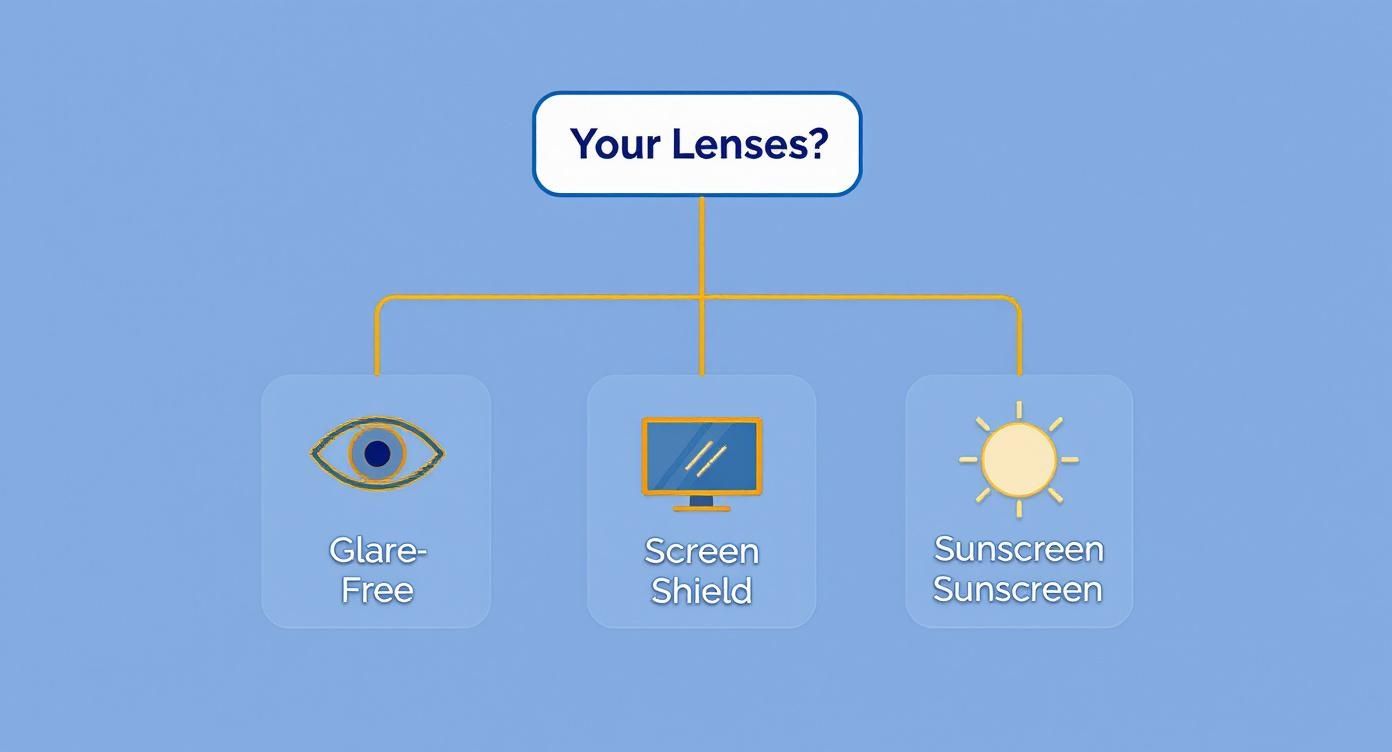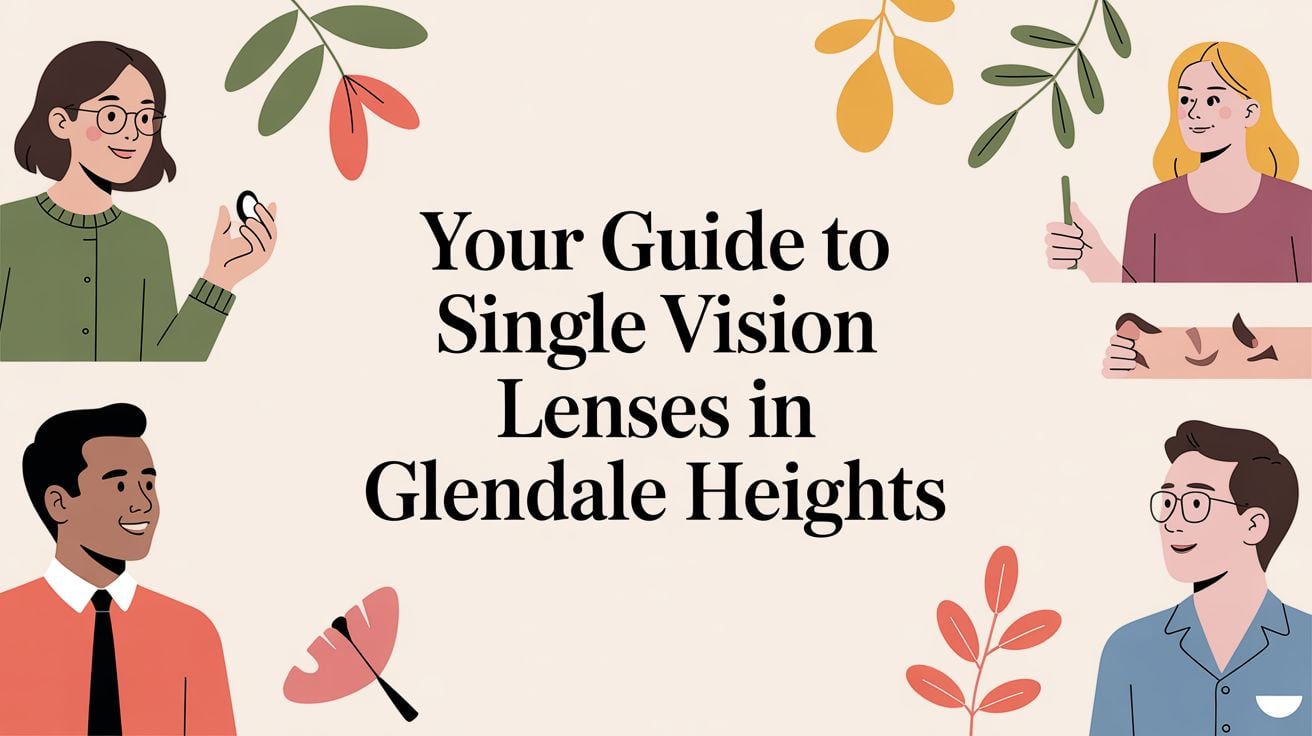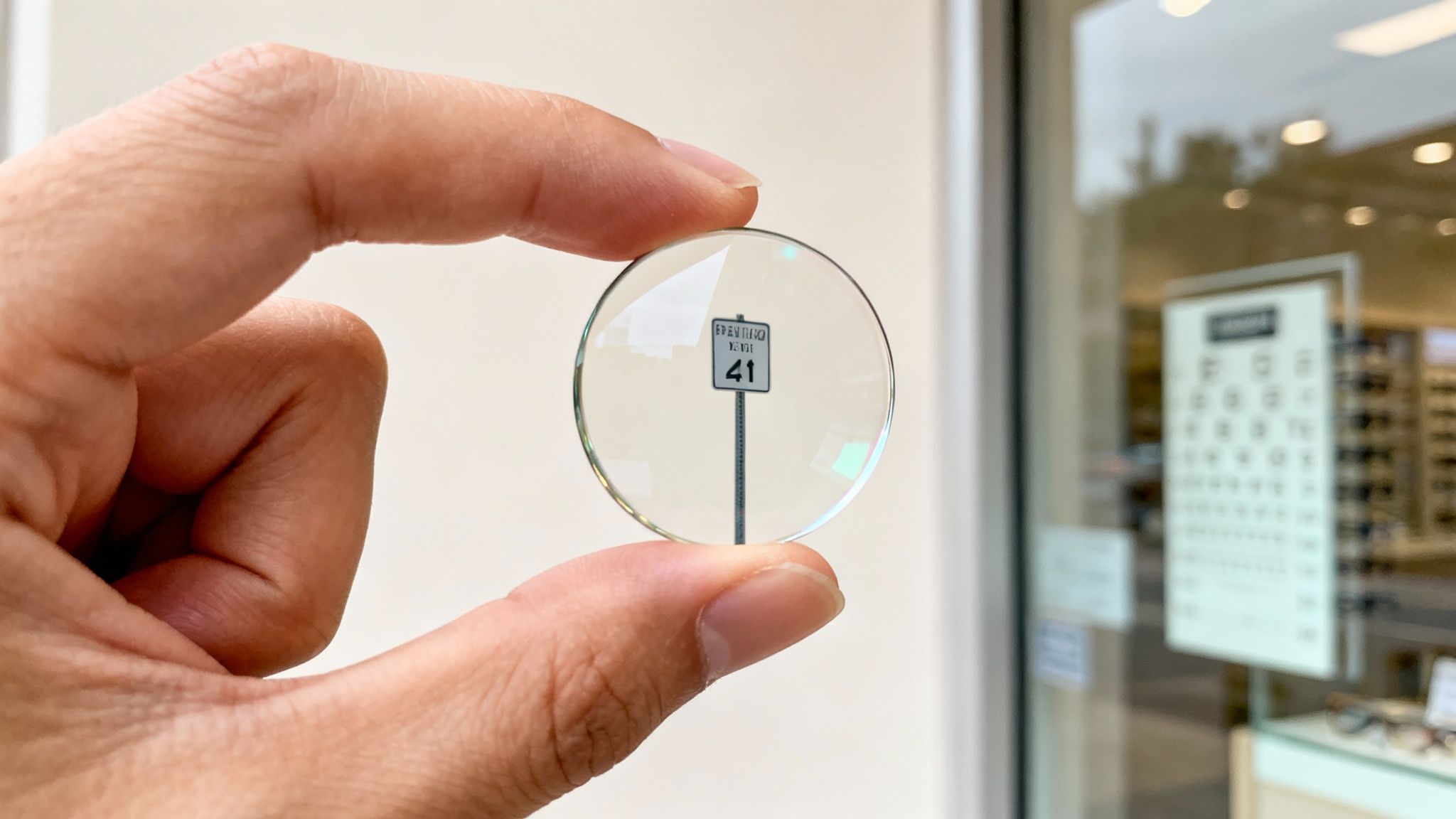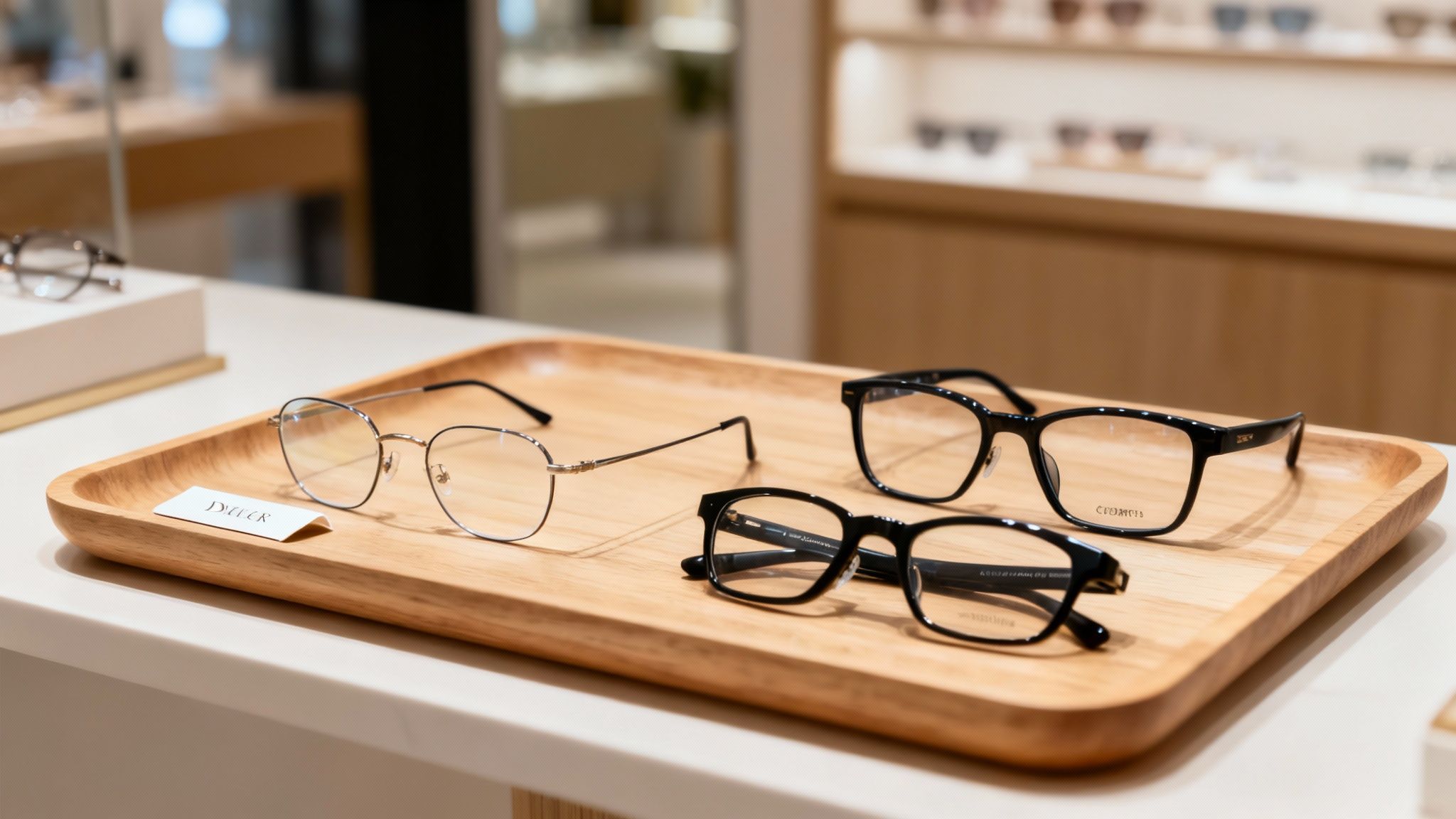If you've ever found yourself asking what single vision lenses are, you're not alone, and the answer is refreshingly simple. They are, by far, the most common type of eyeglass lens out there. Their whole purpose is to correct your vision at one specific distance using a single, uniform prescription power across the entire lens. For many of our neighbors here in Glendale Heights, this is the perfect starting point for clearer vision.
This could mean helping you see things clearly far away, up close, or somewhere in between—but just one of those.
Your Guide to Single Vision Lenses
Welcome to our guide from iDoctor! As the premier optometry boutique for Glendale Heights and our neighbors in Carol Stream and Bloomingdale, we've seen firsthand how these lenses are the foundational solution for millions. When it comes to vision correction, this is often the perfect place to start.
A good way to think about them is like a high-quality camera lens that’s been perfectly focused on one subject. It gives you a crystal-clear, uninterrupted field of view, making it the go-to choice for tackling the most common vision issues.
The Most Common Vision Solution
Single vision lenses are prescribed for a huge variety of everyday needs. Whether you're driving down North Avenue trying to read road signs or settling in with a menu at a local restaurant, these lenses offer a straightforward and incredibly effective fix. They’re built to address one primary visual need with exceptional clarity.
Here at iDoctor, we’re big believers in patient-focused education. We think understanding your eyewear options is the first real step toward achieving your best possible vision. For many people, these lenses are the very first type they’ll wear, especially for conditions that show up in childhood or early adulthood.
Key Takeaway: The defining feature of single vision lenses is their uniform prescription across the entire lens surface. This provides a consistent, clear view for one specific distance.
What Conditions Do They Correct?
These powerhouse lenses are the standard treatment for several very common refractive errors. Our team at iDoctor regularly prescribes them to help patients who have:
- Myopia (Nearsightedness): This is when you have difficulty seeing distant objects clearly.
- Hyperopia (Farsightedness): This is when you have trouble focusing on things up close.
- Astigmatism: This causes blurry vision at all distances because of an irregularly shaped cornea.
For anyone just starting their journey with corrective eyewear, single vision lenses are an excellent and uncomplicated starting point. To explore the full spectrum of options, you can learn about the different kinds of eyeglass lenses in our detailed guide. We’re committed to helping you find the perfect fit for your eyes and your lifestyle.
So, Who Are Single Vision Lenses Actually For?
Single vision lenses are the workhorses of the eyewear world, designed to tackle some of the most common vision problems out there. Think of them this way: if your vision is blurry at one specific distance, these lenses are built to restore that single field of view to perfect clarity. They have one prescription power that runs across the entire lens.
Let’s talk about who really benefits from them, using some real-world examples you might recognize right here in Glendale Heights.
Nearsightedness and Farsightedness
The two biggest reasons people walk into our office for glasses are myopia (nearsightedness) and hyperopia (farsightedness). Single vision lenses are the perfect fix for both.
- Myopia (Nearsightedness): Is your phone screen crystal clear, but the street signs down Army Trail Road are a fuzzy mess? That’s a textbook sign of myopia. It simply means you can see things up close, but your distance vision is blurry.
- Hyperopia (Farsightedness): On the flip side, maybe you can easily read those distant signs, but focusing on your laptop screen or the menu at a restaurant is a real struggle. That points to hyperopia, which makes it tough to see things close to you.
Myopia is becoming incredibly common, especially among younger people, and it’s a huge driver for single vision lens use. In fact, the global market for these specific lenses is expected to reach $2.41 billion by 2025. You can dig into the numbers and see the trends for yourself in this market research analysis.
The Go-To Fix for Astigmatism and Presbyopia
These lenses are incredibly versatile and are also the ideal solution for a couple of other very common vision issues.
Astigmatism is another condition where single vision lenses are a lifesaver. This happens when your cornea isn't perfectly round, causing light to focus unevenly. The result? Blurry or distorted vision at all distances, kind of like looking through a funhouse mirror. A precisely crafted single vision lens corrects that irregularity, giving you sharp focus across your entire line of sight.
Then there’s presbyopia—that natural, age-related change where focusing up close becomes difficult. For this, single vision lenses can be made into dedicated reading glasses. They provide a simple, powerful tool for reading, hobbies, or any other task that requires sharp near vision.
It's easy to try and guess what's going on with your eyes, but only a professional can give you the right diagnosis. Wearing the wrong prescription is a recipe for headaches and eye strain.
Recognizing the signs is a great first step, but a precise, professional diagnosis is the key to truly clear vision. The only way to know for sure what your eyes need is through one of our detailed eye exams in Glendale Heights. At iDoctor, our team uses state-of-the-art equipment to nail down your exact prescription, ensuring your single vision lenses are a perfect match for your eyes.
Choosing the Right Materials and Coatings
Once your prescription is dialed in, the real fun begins: tailoring your single vision lenses to your actual life. It's one thing to have the right numbers; it's another to have glasses that can keep up with you. The material your lenses are made from and the coatings we add are just as critical as the prescription itself.
Think of it this way: a chef needs the right knife for the job. You wouldn't use a cleaver for delicate slicing. The same principle applies here. At iDoctor, we don't just fill a prescription—we help you build the perfect tool for your vision.
Finding the Right Lens Material
Lens material is all about balancing weight, thickness, and toughness. Thankfully, the days of heavy, breakable glass lenses are long gone. Modern optical plastics offer amazing performance and comfort for pretty much any need.
-
Standard Plastic (CR-39): This is the trusty workhorse of the optical world. It's affordable, provides fantastic optical clarity, and is a solid choice for everyday glasses with mild prescriptions.
-
Polycarbonate: If you're active, play sports, or are getting glasses for your kids, this is the material you want. Polycarbonate is incredibly impact-resistant and has built-in UV protection, making it a much safer and more durable option.
-
High-Index Plastics: Have a stronger prescription? High-index materials are a game-changer. They bend light more effectively, which allows us to make your lenses significantly thinner and lighter. This gets rid of that old "coke bottle" effect and results in a much more comfortable and attractive pair of glasses.
Adding Protective and Performance Coatings
Think of coatings as upgrades that supercharge your lenses. These invisible layers protect both your eyes and your investment, cutting down on common frustrations like glare and scratches. They truly make a world of difference in your day-to-day vision.
At iDoctor, we don't see coatings as optional add-ons. They're essential components of modern eyewear, designed to tackle the real-world challenges our eyes face every day, from staring at screens to walking in the bright sun.
Here are a few of the most popular coatings we recommend:
-
Anti-Reflective (AR) Coating: This is a must-have. It eliminates distracting reflections from headlights, overhead lights, and computer screens, giving you clearer, crisper vision, especially when driving at night.
-
Blue Light Filtering: If you spend hours on a computer or phone, this is your new best friend. It filters a portion of the high-energy blue light from digital screens, which can help reduce the feeling of digital eye strain for many people.
-
UV Protection: You put sunscreen on your skin; your eyes need protection, too. A UV coating is like sunscreen for your eyes, blocking the sun’s harmful ultraviolet rays and safeguarding your long-term eye health.
To give you a clearer picture, here’s how these options stack up.
Lens Material and Coating Options at a Glance
This table compares common lens materials and coatings to help you choose the best options for your lifestyle and prescription.
| Feature | Description | Best For |
|---|---|---|
| Standard Plastic (CR-39) | An affordable, reliable material with excellent optical clarity. | Everyday use with low-to-moderate prescriptions. |
| Polycarbonate | Highly impact-resistant and lightweight with built-in UV protection. | Kids, athletes, and safety glasses. |
| High-Index Plastic | A thinner, lighter material that reduces lens thickness and weight. | Stronger prescriptions where aesthetics and comfort are key. |
| Anti-Reflective (AR) Coating | Reduces glare and reflections, improving clarity and aesthetics. | Night driving, computer use, and anyone wanting clearer vision. |
| Blue Light Filtering | Filters a portion of blue-violet light from digital screens. | Heavy computer, phone, or tablet users. |
| UV Protection | Blocks 100% of harmful UVA and UVB rays. | Everyone—it's essential for long-term eye health. |
Navigating these choices might seem a bit overwhelming, but that's what we're here for. We'll help you match the right technology to your daily needs.
To get an even deeper understanding, you can learn more about why next-generation lens coatings matter in our detailed article. Our team is always ready to walk you through every option, ensuring you end up with glasses you'll absolutely love.
Single Vision vs. Bifocal and Progressive Lenses: What’s the Difference?
One of the most common questions we get from patients here at our Glendale Heights boutique is about the differences between lens types. It can sound complicated, but once you understand the basic job of each lens, it all starts to make sense.
Single vision lenses are the most common and straightforward type. They have one single prescription power across the entire lens. This gives you a wide, clear field of view for one specific distance—either seeing things far away, up close for reading, or at an intermediate computer distance.
I like to use a simple bicycle analogy to explain it:
- Single Vision Lenses are like a single-speed bike. They're built to do one thing, and they do it perfectly. Simple, reliable, and great for a specific purpose.
- Bifocal Lenses are like a two-speed bike. You get two distinct powers, one for distance and one for near, with a visible line separating them.
- Progressive Lenses are the modern, multi-gear bike. They offer a smooth, invisible transition through multiple powers, giving you clear vision at all distances—far, near, and everything in between.
When Do You Need More Than One Power?
The need for more than one corrective power usually comes with age. It’s caused by a completely natural condition called presbyopia, which is just a fancy word for your eyes losing the ability to focus on close-up objects. That's when bifocals or progressives become fantastic alternatives to juggling multiple pairs of glasses.
Even so, the simplicity and effectiveness of single vision lenses keep them incredibly popular. Their ease of use and affordability are big reasons why the global market for these lenses was valued at around $10.54 billion in 2024 and is expected to grow to $17.72 billion by 2033. You can see the full breakdown on the sustained growth of single vision lenses.
Deciding when to make a switch and which lens is right for you really comes down to a conversation with your eye doctor. If you're curious to learn more about how multifocal lenses work, we have a helpful guide on progressive lenses and designer frame compatibility.
This decision tree helps illustrate how coatings can be added to customize your single vision lenses for your specific daily activities.

As you can see, these enhancements aren't just generic add-ons; they're tailored to solve real-world problems, whether it's eye strain from screen time or glare from the sun.
Ultimately, the "best" lens is the one that perfectly matches your prescription, lifestyle, and visual comfort.
At iDoctor, our optometrists take the time to conduct a thorough evaluation and understand your needs. Whether a straightforward pair of single vision glasses is the answer or a more advanced multifocal design makes more sense, we're here to make sure your vision is the top priority.
Finding Your Perfect Frames at iDoctor
The perfect single vision lenses are only half the equation—they need the perfect frame to complete the picture. Once we’ve dialed in your prescription, it’s time for the fun part: connecting the science of your vision with the art of your personal style. We know your glasses are a huge part of your identity, and choosing the right frame is just as crucial as the lenses inside.
It might surprise you, but your prescription can actually point you toward the best frame styles. Stronger prescriptions, for instance, often mean thicker and heavier lenses. Not to worry—certain frame materials and shapes are designed specifically to handle these lenses, offering better support while keeping the look sleek and flattering. Our expert opticians are masters at matching you with frames that not only look incredible but also work in harmony with your lenses.
A Collection Curated for Glendale Heights
If you're looking for designer eyeglasses in Glendale Heights, you've come to the right place. We've personally curated a collection of frames from some of the world's most coveted luxury brands. Whether you're drawn to the timeless elegance of Cartier, the bold confidence of Gucci, or the sleek, modern lines of Tom Ford, we have something to reflect your unique taste.
Great style shouldn't be out of reach. That's why we also carry a fantastic selection of beloved, accessible brands, including:
- Ray-Ban
- Kate Spade
- Michael Kors
- Coach
- Oliver Peoples
- Fendi
- Saint Laurent
- Prada
- Tory Burch
With such a diverse range, you’re sure to find a frame that feels just right for both your personality and your budget. The way eyewear is presented can make all the difference, and if you're curious about the art behind it, this guide to professional product photography offers some fascinating insights.
A Personalized Fitting Experience
Picking out a frame isn’t just about the style. It's about finding that perfect, made-for-you fit that ensures you can wear them comfortably all day long. Our team delivers a truly personalized fitting experience, taking meticulous measurements so your lenses are centered precisely and the frames rest perfectly on your face.
We don’t just sell glasses; we build a complete visual solution. Our goal is to make sure you walk out of our Glendale Heights boutique feeling confident and seeing the world more clearly than ever.
From helping you understand how your prescription influences frame choice to finding the ideal shape for your face, we’re with you every step of the way. For a deeper dive, check out our guide on the different types of spectacles frames. This blend of expert lens technology and thoughtful frame styling is why iDoctor is the go-to destination for eyewear in our community.
Why Choose iDoctor for Your Eyewear Needs
Finding the right team for your eye care is a big decision. It’s not just about getting a prescription filled; it's about finding a partner you can trust, who brings real expertise and a personal touch to the table. Here at iDoctor, we're dedicated to giving everyone in our Glendale Heights community an experience that truly stands out.
It all starts with our detailed 30-minute eye exams. We use high-resolution imaging to get a crystal-clear picture of your eye health, ensuring your prescription for single vision lenses is spot-on. This meticulous process is what sets us apart and lays the groundwork for perfect vision.
A Modern Approach to Vision Care
Our boutique is easy to find, whether you live near Glendale Lakes Golf Club or are just passing down Bloomingdale Road. Step inside, and you'll find a handpicked collection of designer frames. We believe clinical precision and high-end fashion go hand-in-hand, so your new glasses will work brilliantly and look fantastic.
The world of eyewear is always moving forward—the global market for single vision lenses alone was valued at $7.03 billion in 2024. As new technologies and materials emerge, we make it our job to stay on top of them to bring you the best options available. You can read more about the latest market growth and trends if you're curious.
We believe great eye care should be accessible. That’s why we proudly accept all major vision insurance plans, making it easier for you to use your benefits without cutting corners on quality.
From the moment you walk in for an exam to the day you pick up your perfectly fitted glasses, our team is here to build a real, lasting relationship with you. We invite you to come see us at iDoctor and discover why we're known as the best optometrist in Glendale Heights. Let us show you the difference that expert, personalized care truly makes.
Frequently Asked Questions
We get a lot of great questions about single vision lenses, and our team at iDoctor is always ready with clear, straightforward answers. Here are some of the most common things patients ask us here in our Glendale Heights office.
How Much Do Single Vision Lenses Cost at iDoctor?
The final price for your single vision lenses really comes down to a few key choices. Your specific prescription, the lens material you pick (like standard plastic versus an ultra-thin high-index), and any extra coatings you add—like anti-glare or blue light filtering—all play a part.
Making great eye care affordable is a big deal for us. We accept all major vision insurance plans, which can significantly lower what you pay. The best way to get an exact price is to come in for a chat. We’ll walk you through the options and find the perfect fit for your vision and your budget.
Can I Put New Lenses in My Own Designer Frames?
Absolutely! This is something we do all the time. Our opticians are experts at fitting brand-new prescription lenses into frames you already own and love, including high-end brands like Cartier, Gucci, and Tom Ford.
It’s a fantastic way to update your vision without giving up the style you’re known for. Bring them in, and we'll handle the rest, ensuring a flawless, secure fit.
How Long Does It Take to Get My New Glasses?
We know you're eager to see the world through your new glasses, and we do everything we can to get them to you quickly. For most standard single vision prescriptions, we can have your glasses ready in just a few business days.
If your prescription is a bit more complex or you've opted for special materials or coatings, it might take a little longer. We're sticklers for quality and want to get it just right. When you place your order with us, we’ll give you a clear, honest timeline. It's also good to remember that your eyes might need a little time to get used to the new prescription. We even have a guide on adjusting to new glasses to help make that process seamless.
Do I Need to Book an Eye Exam in Advance?
Yes, scheduling an appointment for your eye exam is the best way to go. Booking ahead means we can reserve a dedicated time slot just for you, so your exam is thorough and never rushed.
This ensures our optometrist has the time to use our high-resolution imaging technology and dial in your prescription with total accuracy. You can book right on our website or just give our Glendale Heights office a call.
Your vision is everything to us. At iDoctor, we blend deep clinical expertise with a genuine passion for style to give you the best eye care experience in the Glendale Heights area. Stop by our Glendale Heights boutique and see the difference for yourself.
https://idoctoril.com







